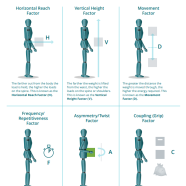Resource Library
Search
Search for keywords that are related to what you're looking for to get the best results (ex. construction). Use filters to refine your search.
Image
An ad-free iPad app that allows users to digitally track visual analog scores using 10 cm slider channels with various customizations and export saved data in tables. It can be used as a pain/…
Image

This video describes how to quantify repetition using the Hand Activity Level (HAL) Scale. The HAL Scale was developed to rate the repetitiveness of hand use. it also accounts for recovery time and…
Image

To help workplaces design and assess lifting and lowering tasks, the American Conference of Governmental Industrial Hygienists, or ACGIH for short, developed an assessment tool. The tool is called…
Image

The National Institute of Occupational Safety and Health (NIOSH) Lifting EquationThe National Institute for Occupational Safety and Health (NIOSH) in the USA identified factors that affected the amount…
Image

Recommended Weight for lifting and lowering: The NIOSH* Lifting Equation*National Institute of Occupational Safety and Health (USA)The National Institute for Occupational Safety and Health (NIOSH) in…
Image

The National Institute for Occupational Safety and Health (NIOSH) in the USA identified factors that affected the amount of weight that could be safely lifted. It was created to help workplaces…
Hyperlink; Assessment–A series of tables with recommended weight limits for lifting tasks given worker sex, object depth, lifting distance, lifting frequency, and lift asymmetry. The data are derived…
